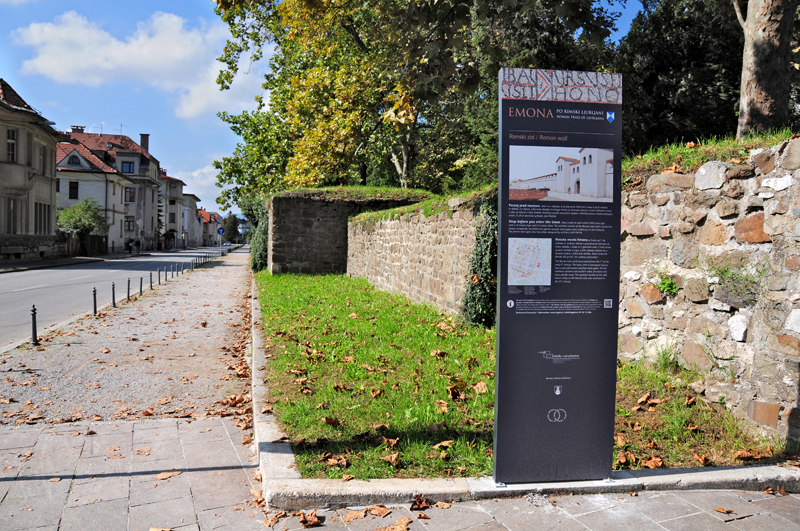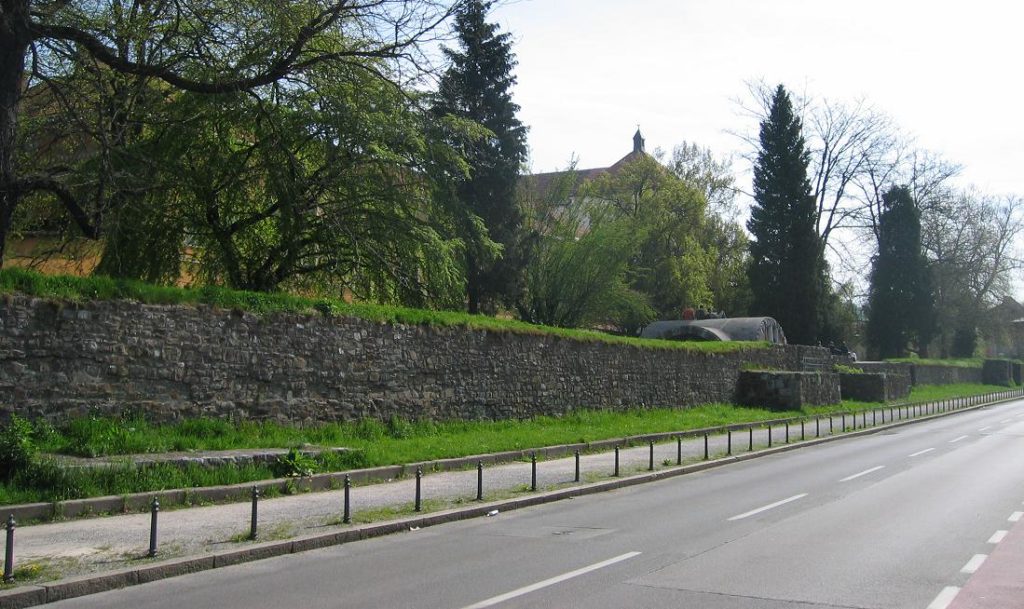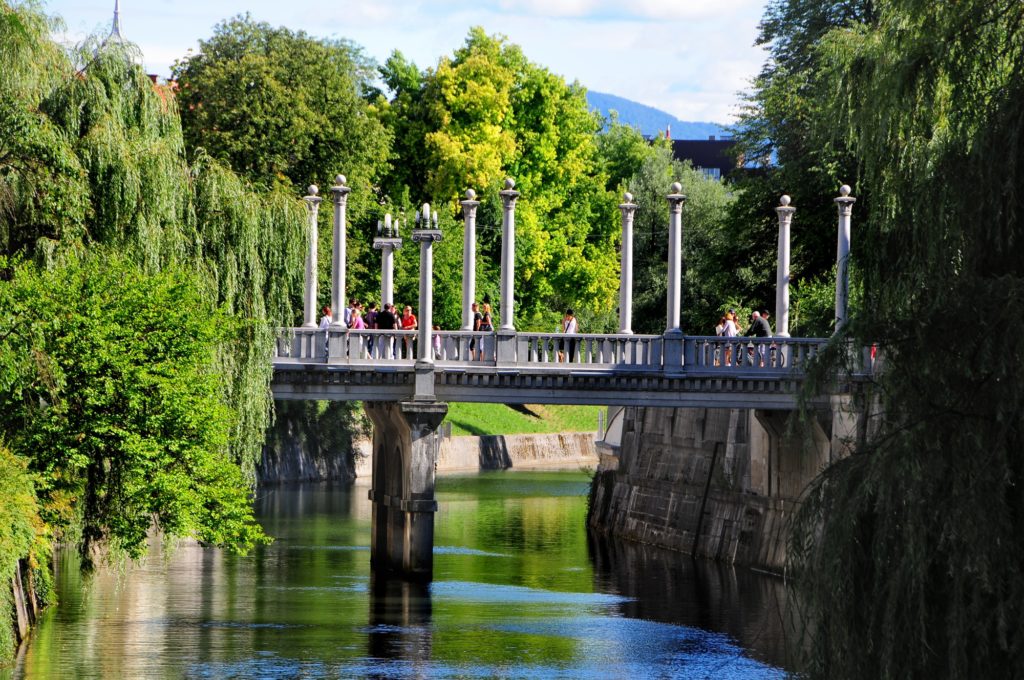Some days are diamonds, Some days are rocks.
It’s fortunate (at least for me) that Ljubljana isn’t a particularly large city. You see, where Ĺ˝ale is north of the Grand Union Hotel, one of the other places I wanted to visit – the remains of the Roman Wall at Mirje – is south. Of course, a cab or other public transportation is always an option but, given my preference for perambulation and the hotel’s centrality, Ljubljana’s size facilitates the more pedestrian choice – three and a half kilometers north to Ĺ˝ale and only about a kilometer and a half south to Mirje.
In my first post about Slovenia, I noted that, as Carniola, it was part of the Roman Empire. During the first century BCE, the Romans built a military stronghold or castrum in the area where the navigable Ljubljanica made its closest approach to Castle Hill. Colonists from the northern part of Roman Italy settled there and named their settlement Colonia Iulia Aemona or, as it’s more commonly known, Emona.
It’s also this location that gives rise to the idea that a predecessor city to Emona was established by Jason and the Argonauts – a claim asserted by Herodotus in the fifth century BCE. Interestingly, the earliest archaeological remains thus far found point to a first settlement sometime around 1,200 BCE which fits in, to some degree with Herodotus’ account.
This walk proved to be a bit less urban than the walk to Žale. En route, I passed the charming Art Nouveau Ljubljana Slovene National Theatre Drama.
The theater grew to become a home to the Slovene Dramatic Society that had staged the first Slovene language drama performance in 1867.
According to my preparatory research, the remains of the wall I’d see were built between the years 14 and 15 CE and formed the southern side of the fortification. The wall runs for two blocks along Mirje Street. I knew I’d found it when I reached the marker in the photo below.
Walking along the wall,
things seem quite ordinary until you reach this apparently incongruous spot:
The pyramid is the handiwork of none other than JoĹľe PleÄŤnik – a flourish he added during a 1930 renovation of the wall complex. As far as I was willing to look, he never revealed the reason for this inexplicable and seemingly bizarre choice.
Returning toward the city center, I detoured past the Cobblers’ Bridge. There has been some crossing of the Ljubljanica in this location since the 13th century and in the Middle Ages it was known as the Upper Bridge. (The original crossing at the location of today’s Triple Bridge was called the Lower Bridge.) It started as a wooden bridge with butchers’ shops on it, but the stench from the meat was so strong that someone paid the butchers to relocate farther downstream. The succeeding occupants of the shops were shoemakers giving the bridge its present name.
Like many of the wooden bridges spanning the Ljubljanica, the Cobblers’ Bridge has burnt and been reconstructed more than once. In 1867, one of the first hinged bridges in the world and the only preserved cast iron bridge in Slovenia, was built on the site and named the Hradecky Bridge (Hradeckega most) for a former mayor. The Hradecky Bridge has been relocated twice. It now crosses the river about half a kilometer south of its former location and is sometimes called the Mortuary Bridge because it was, at one time, used to transport the dead from the Ljubljana hospital to the mortuary.
As for the Cobblers’ Bridge, when the city first relocated the Hradecky Bridge in 1931, they engaged (you guessed it) JoĹľe PleÄŤnik to design the new bridge. Of course, knowing what you now know about PleÄŤnik, one look
at all those columns should be the only clue you needed.
…nothing can capture a heart.
I think I’ve covered all the highlights of my solo wanderings around Ljubljana so now let me rejoin the band of OAT travelers. I’m sure you’ve gathered by now that before I embark on my travel adventures, I research the history, customs, and, to a lesser degree, the language(s) of the places I’m about to visit. I also try to discover unique places to eat and visit. I don’t, for some reason, look for other interesting ways to visit them so credit for our Ljubljana Music Walk goes to Pat and Geanie who discovered it.
I didn’t ask them but I’m going to assume that they didn’t know about one of the factors that makes a music tour a particularly appropriate activity in Ljubljana. One of the first things we learned from our guide, Alenka, when we met her in Prešeren Square, was that in 1995 archaeologists working at the Divje Babe sight in Northwestern Slovenia near Cerkno discovered a cave bear femur pierced with two holes. Some believe this is the oldest known musical instrument in the world.
The 43,100-year-old flute is displayed in the National Museum of Slovenia. (Sadly, I couldn’t squeeze this in during my time in Ljubljana.) According to Wikipedia, the museum’s brochure states that its “manufacture by Neanderthals “is reliably proven”. However, that same article states that a Slovenian archeologist maintains that, “it was made by Cro-Magnons as an element of Central European Aurignacian culture.” Regardless, the history of music has ancient ties to the region.
Before we headed off to Congress Square, Alenka, presented an overview of the tour on which we were about to embark. I was excited for what we were about to discover. We stopped first near the yellow Academia Philhamonicorum building. Recall from the third Feeling sLOVEnia chapter (where you can see a photo of the building) that this Academia was the third oldest in Europe. We learned from Alenka that it was also the first of its kind in Austro-Hungary.
Over the years, the Academia inducted many honorary members including such notable musicians as Beethoven, Brahms, and Paganini. It’s a bit unclear whether any of them spent meaningful time in Ljubljana but we can be certain that Gustav Mahler, who served as the Academia’s principal conductor in 1881-1882, did.
We walked across the square where we met the violinist (whose name I regret to say I’ve forgotten) who would provide the musical accompaniment to our walk. Since Beethoven had been an honorary member in the Academia, his first selection was the opening of the Ode to Joy.
Our next stop was a section of Vegova ulica or Vega Street that is commonly known as the Alley of Slovenian Composers. This is a spot that doesn’t appear in the tourist guides or gets no mention on TripAdvisor. Now, it’s likely that few Americans are familiar with the composers honored here but the street is in a lovely neighborhood and provides a chance to note some names and perhaps broaden our musical experience.

For example, here’s a song by Fran GerbiÄŤ, one of the honored composers:.
One person whose bust we didn’t see was Jurij Slatkonja. He wasn’t a composer (or if he was, none of his work survives) but he was a choirmaster from Carniola who became the first residential Bishop of Vienna (under the Germanic sounding name Georg von Slatkonia). In 1498, he was granted the position of Singing Master of the choir that eventually became known as the Vienna Boys Choir.
A very short walk from composer’s alley is another sight I pointed out in the Feeling sLOVEnia post, PleÄŤnik’s Illyrian Monument on French Revolution Square dedicated to Napoleon. I should note that it was today’s guide, Alenka, who provided the background information in that section.
Continuing along our walk, we next stopped outside the Ljubljana University Library. Alenka chose this as a place to stop in part because it’s one of her favorite buildings in the city. Like so many places in the city, this building was another work attributable to PleÄŤnik who embedded much symbolism in his design.
The white stones represent the Alpine region and the red brick the Karst. The windows are designed to represent open books. Even the interior design where the small dark entry leads you into large naturally well-lit reading rooms was intended to symbolize the passage from darkness and ignorance to knowledge and light.
At one time, a Baroque mansion occupied this site. It was owned by an Austrian count renowned for hosting concerts for his guests, was severely damaged in the 1895 earthquake, and, since it couldn’t be rebuilt, was replaced by the library. Nearby was a Baroque church from the early 18th century built by Domenico Rossi who is perhaps best known for his renovation of the Cathedral of Udine. We also heard this music at this spot:.
(As the camera pans the square, you can spot Alenka at about a minute into the video standing next to the woman in the striped shirt.)
We’ll finish the tour and I’ll receive a rather maddening bit of information in the next post.






